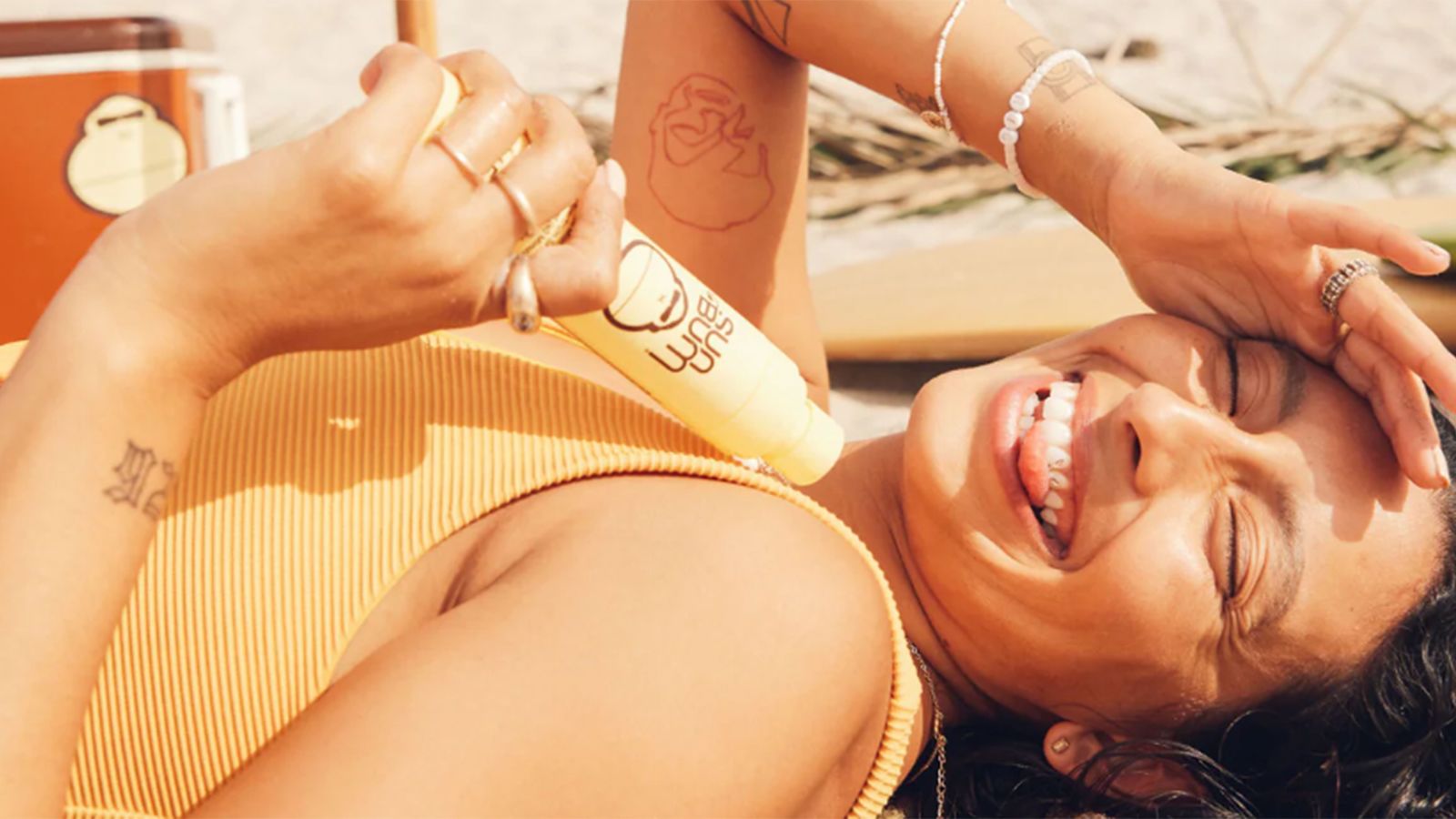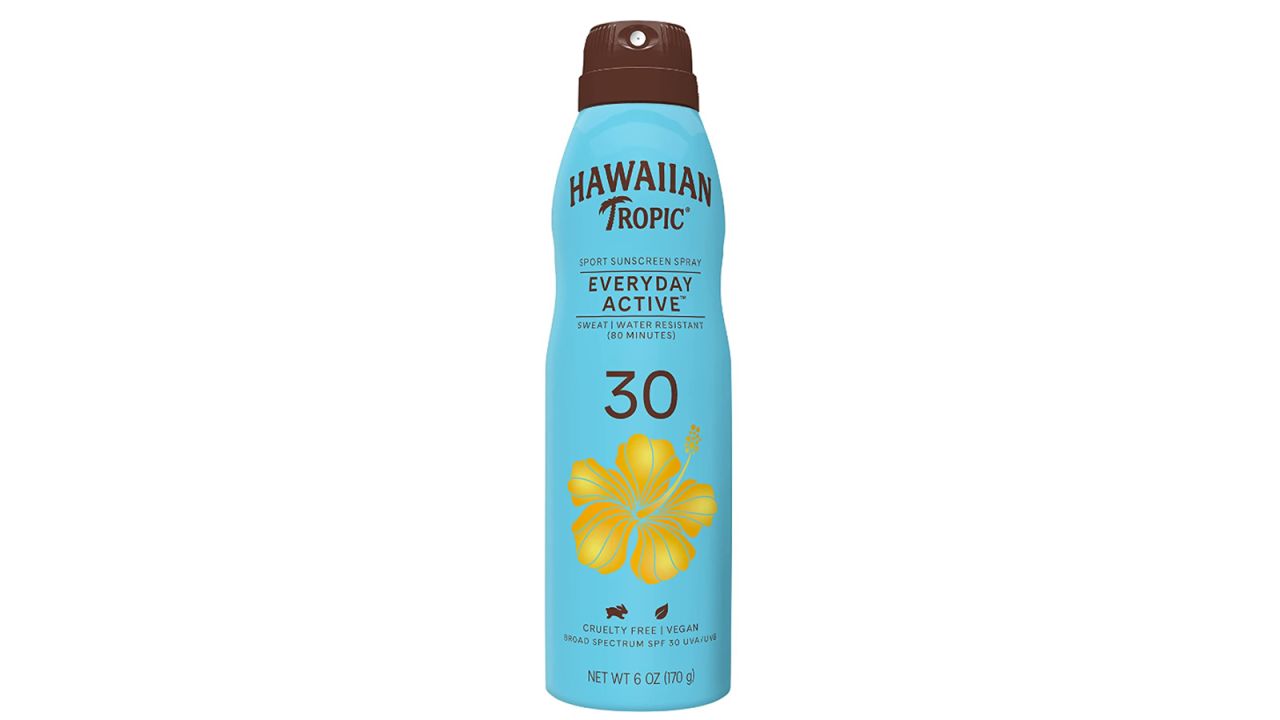Whether you’ve got fair skin, a darker skin tone or land somewhere in the middle, protecting your skin from the sun is important. There’s no worse way to ruin what was an amazing day at the beach than getting home and realizing you’re as red as a lobster. And even if you don’t burn so easily (or at all), it’s still important to shield yourself from exposure to the sun’s rays, since they can cause damage to your skin in other ways, including skin cancer and premature aging. That’s why wearing a proper sunscreen is essential when spending time in the sun. But even if trips to the beach are getting few and far between, that doesn’t mean you should stop wearing sunscreen, since you should be wearing it indoors anyway as part of your skin care routine (yes, really!).
To help you find the best sunscreen, we talked to experts about the active ingredients and other important factors you should look for. We narrowed down a pool of 12 contenders and went hands-on with each of them for several weeks. Our pool included both mineral and chemical broad-spectrum sunscreens with a minimum SPF of 30. We avoided sunscreens that have oxybenzone, or either of the two active ingredients the FDA proposed as unsafe (aminobenzoic acid and trolamine salicylate).
To be clear, we didn’t test how well these sunscreens protect skin from the sun — for that, we relied on information from the US Food and Drug Administration and the experts we talked to (scroll down to see what they had to say). Too many variables (skin type, time of day, the sun’s intensity, etc.) made it impossible to accurately measure efficacy in our real-world testing. Rather, we had multiple testers with different skin types and tones test them for other variables such as feel, appearance on the skin, smell, ease of application and more.
After multiple weeks of testing, we found three sunscreens that stood above the rest.
Best overall sunscreen: Hawaiian Tropic Island Sport Sunscreen Spray
$14 at Amazon; $13 Walmart; $10 Hawaiian Tropic
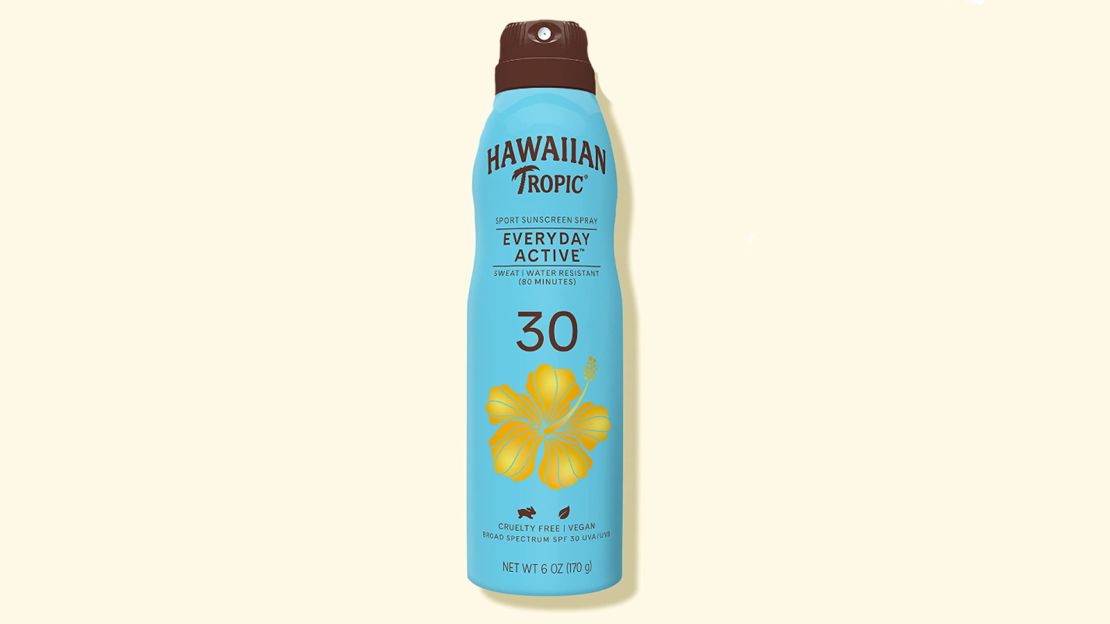
The Hawaiian Tropic Island Sport Sunscreen Spray achieved a perfect score in nearly every single one of our tests. Its spray function made it extremely easy to apply, and it has a wide and even distribution, making it easy to quickly cover your entire body with a swift pass; it clocked in with the fastest full-body application for the testers who tried it out.
The spray disappeared nearly immediately into the skin and didn’t leave any lingering color or sheen. It felt a little wet at first but soon absorbed, and we completely forgot we’d even applied it. The spray’s tropical smell of coconut was pleasant, though it has a hint of chemicals and is quite strong overall, which could deter people with more sensitive senses of smell.
In addition to being a quick and easy sunscreen to apply, the Hawaiian Tropic Island Sport Sunscreen comes in a slim container that barely takes up any room in a bag, plus it can easily fit in a standard water bottle pouch on the side of a backpack. The cap twists into a lock position, so wherever you store it, you can be sure it won’t leak or soak any of your belongings.
The Hawaiian Tropic Island Sport Sunscreen Spray will protect you from the sun with its expert-approved, broad-spectrum SPF 30 formulation. It’s water- and sweat-resistant for 80 minutes, and is made without the chemical ingredients that the FDA and other studies have warned us to avoid. It’s incredibly easy to apply and its smell, feel on the skin and lack of streaking place it solidly as our pick for best overall sunscreen.
Runner-up: Alba Botanica Sport Sunscreen
$11 at Amazon
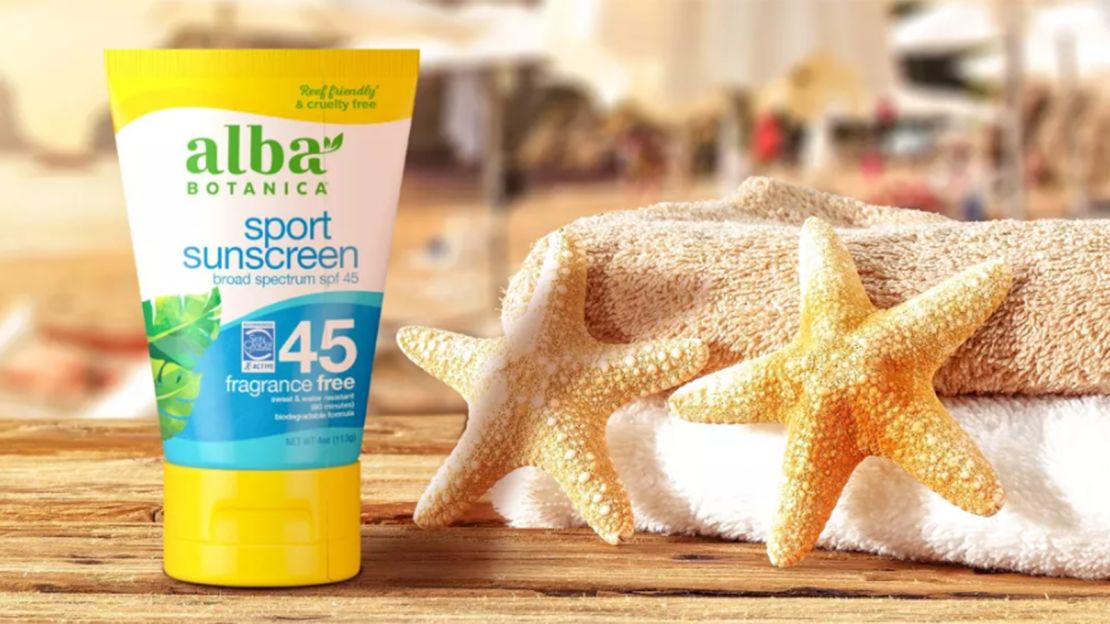
If you don’t want a spray or if you have a sensitive sense of smell, then the Alba Botanica Sport Sunscreen is the pick for you. It scored remarkably high in our testing, a few points below our overall winner, just beating out the cult-favorite Sun Bum sunscreen (which we also loved; scroll down to read about other sunscreens we tested). The chemical sunscreen shone brightest in its ease of application and ability to disappear right into the skin. Its light texture rubbed in quickly, and one of our testers even said it left her skin looking glowy.
The Alba sunscreen is marketed as fragrance-free, which rings mostly true as both our testers loved its light and subtle scent. The only dings really came with the sunscreen’s feel, as it was a little thick and left a chalky feeling on one tester’s fingers after application.
Alba’s sunscreen comes in a small, compact bottle so you can easily stash it in any bag. The cap snaps shut, and while it doesn’t have a locking mechanism, it’s quite secure and shouldn’t leak.
The Alba Botanica Sport Sunscreen’s broad-spectrum, SPF 45 lotion met all of the experts’ standards for offering stellar sun protection, while avoiding the harsh chemicals the FDA has proposed as unsafe. If you’re looking for a sunscreen lotion that goes on fast or an option with little to no scent, we think the Alba Botanica Sport Sunscreen is the best one to keep you covered.
Best mineral sunscreen: Coppertone Pure & Simple Sunscreen Lotion
$11 $10 at Amazon; $12 at Target; $11 at Walmart
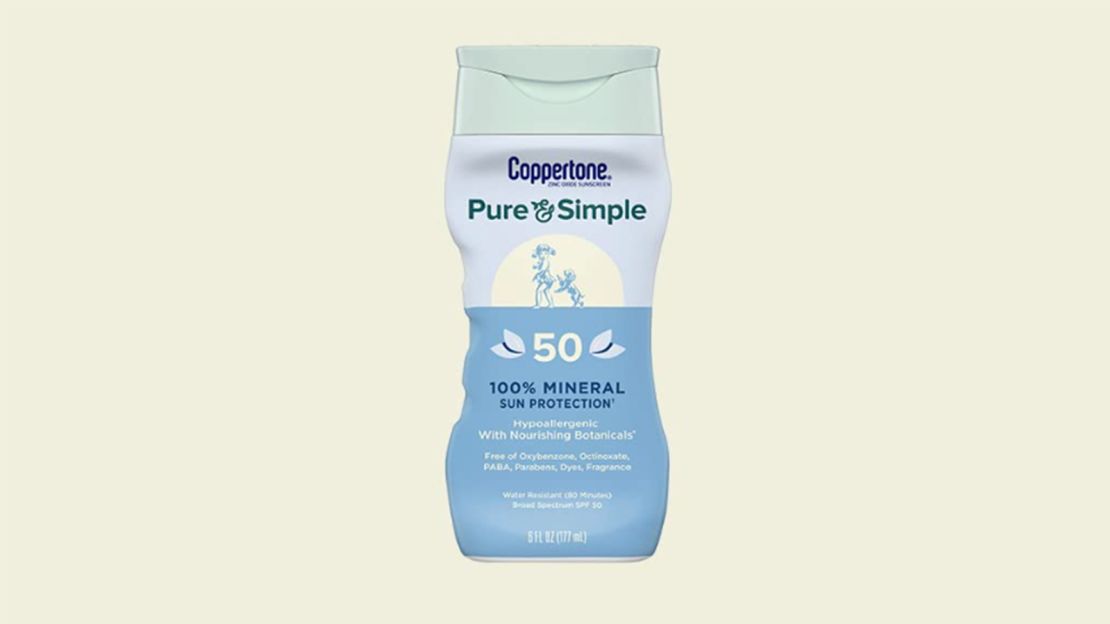
If you want to be extra safe and completely avoid chemical active ingredients, a mineral sunscreen is the way to go, according to the experts we spoke to. While this variety is generally thicker and harder to rub in than a chemical sunscreen, out of all the mineral options we tested, the Coppertone Pure & Simple Sunscreen Lotion stood out above the rest.
Alba Botanica’s Fragrance-Free Sensitive Mineral Sunscreen fell short of our “best mineral sunscreen” spot because it was harder to rub in than the Coppertone, but the Alba mineral sunscreen does come in a spray bottle, which might be a plus for some.
The Coppertone formula is an SPF 50, broad-spectrum lotion with only one active ingredient: zinc oxide. The Coppertone excelled in tests where mineral options normally fell short, namely in ease of application and sunscreen visibility. The lotion itself is thin enough that it applies smoothly to the skin. However, like all mineral sunscreens we tested, it took a while to sink in. One of our testers saw a slight but noticeable white cast on her skin after applying, while another said it took some rubbing but most of the chalkiness and color eventually disappeared.
This sunscreen didn’t have much of a smell, though our testers did pick up a slight chalky, mineral scent. The Coppertone felt gentle on the skin, with no issues or irritation, which makes it a go-to option for anyone with sensitive skin, including children.
If you want to avoid chemical sunscreens altogether, there are plenty of mineral options out there. Many of them take more time to apply and might leave a white cast, but if you want a sunscreen that offers safe protection and isn’t a chore to put on, you won’t find one better than the Coppertone Pure & Simple Sunscreen Lotion.
How we chose our testing pool
We selected 12 sunscreens to test after extensively researching the different types available, their active ingredients and minimum requirements for effective protection against the sun. We relied heavily on research done by the FDA and spoke to various experts who echoed and supported the conclusions of the FDA.
We tested only sunscreens that were broad-spectrum (meaning they block both UVA and UVB rays), had an SPF of 30 or above, and didn’t contain oxybenzone or either of the two ingredients the FDA suggested as unsafe (aminobenzoic acid — commonly referred to as PABA — and trolamine salicylate).
We interviewed several experts, including dermatologists, to create these criteria. Dr. David Colbert, the founder and head physician at New York Dermatology Group, said micronized zinc oxide or titanium dioxide (the two mineral sunscreen ingredients) are the best active ingredients to look for because they are inertly safe. “Chemical sunblocks — the super long words most people can’t say or spell such as methoxycinnamate — can get into the bloodstream and into the environment,” he says. “I prefer physical sunblocks and of course sunblock clothing and umbrellas.”
The experts we talked to also praised physical sunscreens for their gentleness on skin. “The physical sunscreens’ ingredients, zinc oxide and titanium dioxide, tend to be better tolerated by people with sensitive skin and can usually be found in sunscreens for babies and children,” says Dr. Elisabeth G. Richard, a member of the photobiology committee at The Skin Cancer Foundation, who’s also a practicing dermatologist and assistant professor at Johns Hopkins University School of Medicine. Above all, Richard says, what’s more important than the ingredients in your sunscreen is whether you use it. “We believe the best sunscreen is the one you’ll use,” she says. “What’s most important is choosing a broad-spectrum sunscreen with an SPF of 30 or higher every day that suits your skin and activity.”
What to look for in a sunscreen
With so many different active ingredients and types of sunscreens, it can be overwhelming to know what to look for. The FDA complicated matters a bit more when it proposed a new rule in February 2019 calling for more research on certain sunscreen ingredients. “We are requesting additional information on these ingredients so that we can evaluate their GRASE [generally recognized as safe and effective] status in light of changed conditions, including substantially increased sunscreen usage and exposure and evolving information about the potential risks associated with these products since they were originally evaluated,” the agency wrote.
The FDA also recently found that seven common sunscreen chemicals can be absorbed into your bloodstream, although it stated that doesn’t mean you should necessarily stop using those ingredients: “The fact that an ingredient is absorbed through the skin and into the body does not mean that the ingredient is unsafe.”
Richard says if people are concerned about absorption they should use physical (often called mineral) options, and, “Out of an abundance of caution, pregnant and nursing women may want to consider using mineral sunscreens.”
With all these new findings, choosing a safe and effective sunscreen can be a challenging task, which is why we dove deep into the research and interviewed experts to identify the best options. They all agreed that using a broad-spectrum protection sunscreen, which shields you from both UVA and UVB rays, is critical. On top of that, you should use a product with an SPF of at least 30, which tells you how long it takes for the UV rays to hit and damage your skin. So, using an SPF 30 — exactly as directed on the product’s packaging — means it will take you 30 times longer to burn compared with not wearing any sunscreen.
It’s also important to find a sunscreen that has a rating for water resistance. “If you’re going to be swimming or sweating, look for sunscreens labeled water-resistant, which are tested to be effective for up to 40 minutes of swimming,” Richard says. “Very water-resistant sunscreens stay effective for up to 80 minutes in the water.”
Where it gets more complicated is deciding which kind of sunscreen ingredients you should use. We found that physical (mineral) sunscreens are your safest bet for protection, as none of the ingredients absorb into your bloodstream. Mineral sunscreens contain zinc oxide, titanium dioxide or both, but they are normally thicker and whiter and don’t disappear as well into your skin as their chemical counterparts. Mineral sunscreens work by physically blocking the rays of the sun so they don’t reach your skin. Chemical sunscreens, on the other hand, work by absorbing the rays so your skin doesn’t have to.
In the world of chemical sunscreens, there are two active ingredients you should definitely avoid: aminobenzoic acid (PABA) and trolamine salicylate. In 2019, the FDA proposed that these do not meet the standards to be “safe and effective” for sunscreen use.
The FDA still wants more safety information on 12 other chemical sunscreen ingredients, but there are some studies about one ingredient in particular, oxybenzone, that have discovered a potential link between the chemical and lower testosterone levels, hormone changes in men, shorter pregnancies in women and disrupted birth weights in babies. However, according to CNN Health, experts caution about assuming an association between exposure and those outcomes. Oxybenzone is one of the seven active ingredients that were found to absorb into your bloodstream, and Hawaii, Key West and the Pacific nation of Palau have banned sunscreens containing oxybenzone because of its impact on coral reefs. To be extra cautious, we didn’t include any sunscreens that contain oxybenzone in our tests.
Best practices for sun protection
While finding the perfect sunscreen that has broad-spectrum coverage and an SPF of at least 30 is critical to protecting yourself from the sun, many experts we talked to also made sure to point out that avoiding sun damage doesn’t end with a good sunscreen.
“While sunscreen is an important part of a sun protection strategy, it is not our only protection,” says Richard. “Remember that clothing, shade structures, sunglasses are all additional measures to use when protecting your skin from UV rays.” And Amanda Turney, a press officer at the FDA, encourages consumers to limit time in the sun, “especially between the hours of 10 a.m. and 2 p.m., when the sun’s rays are most intense.”
• Related: The best face sunscreens, according to dermatologists
How we tested
We ran each sunscreen through the same set of tests to measure both performance and portability. We did not test each sunscreen’s ability to protect you from the sun’s rays, but instead relied on our extensive research and the opinions of experts we interviewed to create criteria that all the sunscreens we tested met. Our performance ratings were instead based on tests that focused on the products’ ease of application, visibility, smell and other variables. Since many of these tests are subjective, we had two testers evaluate each sunscreen and took the average of both results. Here’s a full breakdown of every test we ran.
Performance
- Ease of application: Testers applied the sunscreen according to its directions and noted how difficult it was to apply to their entire bodies.
- Time of application: Each tester applied the sunscreen three times and found the average time it took to apply the product thoroughly.
- Sunscreen visibility: After applying each sunscreen, we noted if it left any color or white marks on the skin, or if it disappeared completely.
- Sunscreen feel: We examined how the sunscreen felt on the skin, noting if it was sticky, greasy, thick or thin.
- Sunscreen smell: We smelled the sunscreen whenever we applied it and noted if it had a pleasant scent.
Portability
- Leaks: We examined the bottle to see if it would leak easily, giving points to sunscreens with secure caps.
Other sunscreens we tested
Hawaiian Tropic Sheer Touch Lotion Sunscreen
$13 at Target
The Hawaiian Tropic lotion sunscreen performed quite well, but not as well as its spray-bottle counterpart. It lost a few points on ease of application and size. Overall, it’s a solid sunscreen that rubbed into the skin well and wasn’t too thick, but its tropical, fruity smell may be overpowering to some.
Banana Boat Sport Sunscreen Spray
From $9 at Amazon
This chemical sunscreen also scored very well in our testing, achieving high marks for ease of application, how it felt on the skin and visibility. One of our testers said it was a little harsh on her sensitive skin, though, and the chemical smell can be overbearing. But if those factors aren’t an issue for you, this option from Banana Boat is a top-notch spray sunscreen.
Sun Bum Original SPF 30 Sunscreen Lotion
$18 at Ulta
Sun Bum’s chemical sunscreen was one of our favorites. It has a light texture that rubs in quickly, and boy oh boy, does it smell good. The creamy banana scent had us reaching for Sun Bum more than most of the other options in our test pool. It was just a few points shy of our winners because it took more time to apply than the sprays and comes in a bottle that’s a bit bulky.
MDSolarSciences Mineral Moisture Defense SPF 50
$27 at Amazon
MDSolarSciences is one of the most expensive sunscreens we tested, but it fell short of our top picks in many categories. It didn’t have a discernible scent, which was nice, but it felt greasy on the skin, making our testers sweat more and leaving them desperately wanting a shower.
California Kids Supersensitive Broad-Spectrum Tinted Sunscreen
$26 at Walmart
The biggest issue with this mineral sunscreen from California Kids was how long it took to rub into the skin. It lacks a strong scent, which is a plus, but both our testers docked points because it left a white residue that wouldn’t go away.
Thinksport Safe Sunscreen SPF 50+
$15 at Amazon
This sunscreen is made with the sole active ingredient of zinc oxide. It was incredibly thick and took quite a while to fully apply; even after our testers took a long time to thoroughly rub it in, it left white streaks. Several other mineral options we tested, such as the Coppertone and Alba sunscreens, were much easier to apply.
Alba Botanica Fragrance-Free Sensitive Mineral Sunscreen
$10 at Amazon
This spray sunscreen from Alba was a close second to the Coppertone for our pick for best mineral sunscreen. The spray function made application a much faster process, but we still had to rub in the sunscreen a lot, as it came out white and chalky.
CeraVe Broad-Spectrum Sunscreen Stick
$10 $9 at Amazon
The CeraVe Sunscreen stick is a fantastic option for a portable sunscreen you can keep in your purse, but its small size means it’s a pain to apply to your entire body. It scored well in our tests, almost claiming the title of best mineral sunscreen, but we ultimately chose the Coppertone Pure & Simple Sunscreen Lotion since it’s a better option for full-body application. The CeraVe is a mineral formula and has a decent smell and feel, but where it really shone was with its petite size and ultimate portability.
Colorescience Sunforgettable Total Protection Body Shield
$46 at Colorescience
This mineral sunscreen is the most expensive on our list, but it scored lower than many other, cheaper options. It didn’t feel amazing on the skin, with one tester describing it as matte and silky, but still as though there were a thick film on his skin. It had a light scent that’s reminiscent of makeup, but it’s just too expensive compared with the other, better options we tested.
Read more from CNN Underscored’s hands-on testing:
